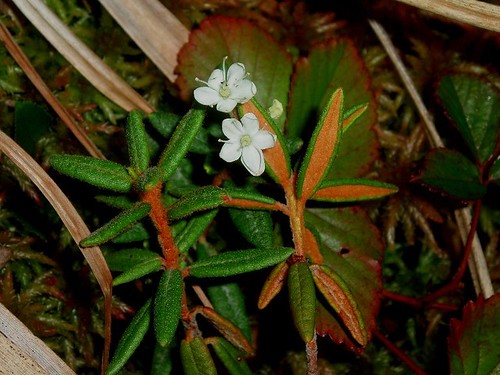 Species Factsheets
Species Factsheets
Rhododendron groenlandicum
Labrador Tea
State Status: Pennsylvania Rare (PR)
PBS Status: Pennsylvania Rare (PR)
Federal Status:
Global Rank: G5
![]() rank interpretation
rank interpretation
State Rank: S3
Did You Know?
This species makes Labrador tea, which has been used historically for colds, skin complaints and malignancies.
Description
Labrador tea (Rhododendron groenlandicum) is an evergreen shrub with dense, orangish or brownish, woolly hairs on the branchlets. The leaves are thick and leathery, tend to have the margin curled under, and have abundant orangish or brownish (or whitish when young), woolly hairs on the undersurface. The white flowers have five petals and appear in May or June. The fruit is a cylindrical-shaped capsule. The species is easily recognized at any time of the year.
Rank Justification
Vulnerable in the nation or state due to a restricted range, relatively few populations (often 80 or fewer), recent and widespread declines, or other factors making it vulnerable to extirpation.
PABS
Labrador tea has been given a status of Rare on the Plants of Special Concern in Pennsylvania list by the Pennsylvania Biological Survey and the Department of Conservation and Natural Resources, based on its rather localized distribution in the state and peatland habitat. It may be abundant where established
Habitat
The species grows in bogs and other types of peaty wetlands.
Survey Dates
Flowers June
Distribution

Threats
.
Conservation Status Map

NatureServe. 2017. NatureServe Explorer: An online encyclopedia of life [web application]. Version 7.1. NatureServe, Arlington, Virginia. Available https://explorer.natureserve.org.
https://www.drugs.com/npp/labrador-tea.html
- NatureServe. 2018. NatureServe Explorer: An online encyclopedia of life [web application]. Version 7.1. NatureServe, Arlington, Virginia. Available at https://www.natureserve.org/explorer
- Pennsylvania Natural Heritage Program. 2018.
- Rhoads, A.F. and W.M. Klein, Jr. 1993. The Vascular Flora of Pennsylvania. American Philosophical Society, Philadelphia, Pennsylvania. Rhoads, A.F. and T.A. Block.
- 2007. The Plants of Pennsylvania: An Illustrated Manual. 2nd edition. University of Pennsylvania Press, Philadelphia, Pennsylvania.







